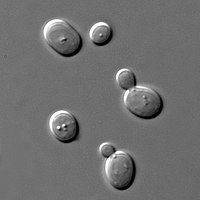
Photo from wikipedia
ABSTRACT Saccharomyces cerevisiae has a sophisticated signalling system that plays a crucial role in cellular adaptation to changing environments. The SNF1 pathway regulates energy homeostasis upon glucose derepression; hence, it… Click to show full abstract
ABSTRACT Saccharomyces cerevisiae has a sophisticated signalling system that plays a crucial role in cellular adaptation to changing environments. The SNF1 pathway regulates energy homeostasis upon glucose derepression; hence, it plays an important role in various processes, such as metabolism, cell cycle and autophagy. To unravel its behaviour, SNF1 signalling has been extensively studied. However, the pathway components are strongly interconnected and inconstant; therefore, elucidating its dynamic behaviour based on experimental data only is challenging. To tackle this complexity, systems biology approaches have been successfully employed. This review summarizes the progress, advantages and disadvantages of the available mathematical modelling frameworks covering Boolean, dynamic kinetic, single-cell models, which have been used to study processes and phenomena ranging from crosstalks to sources of cell-to-cell variability in the context of SNF1 signalling. Based on the lessons from existing models, we further discuss how to develop a consensus dynamic mechanistic model of the entire SNF1 pathway that can provide novel insights into the dynamics of nutrient signalling.
Journal Title: FEMS Yeast Research
Year Published: 2022
Link to full text (if available)
Share on Social Media: Sign Up to like & get
recommendations!